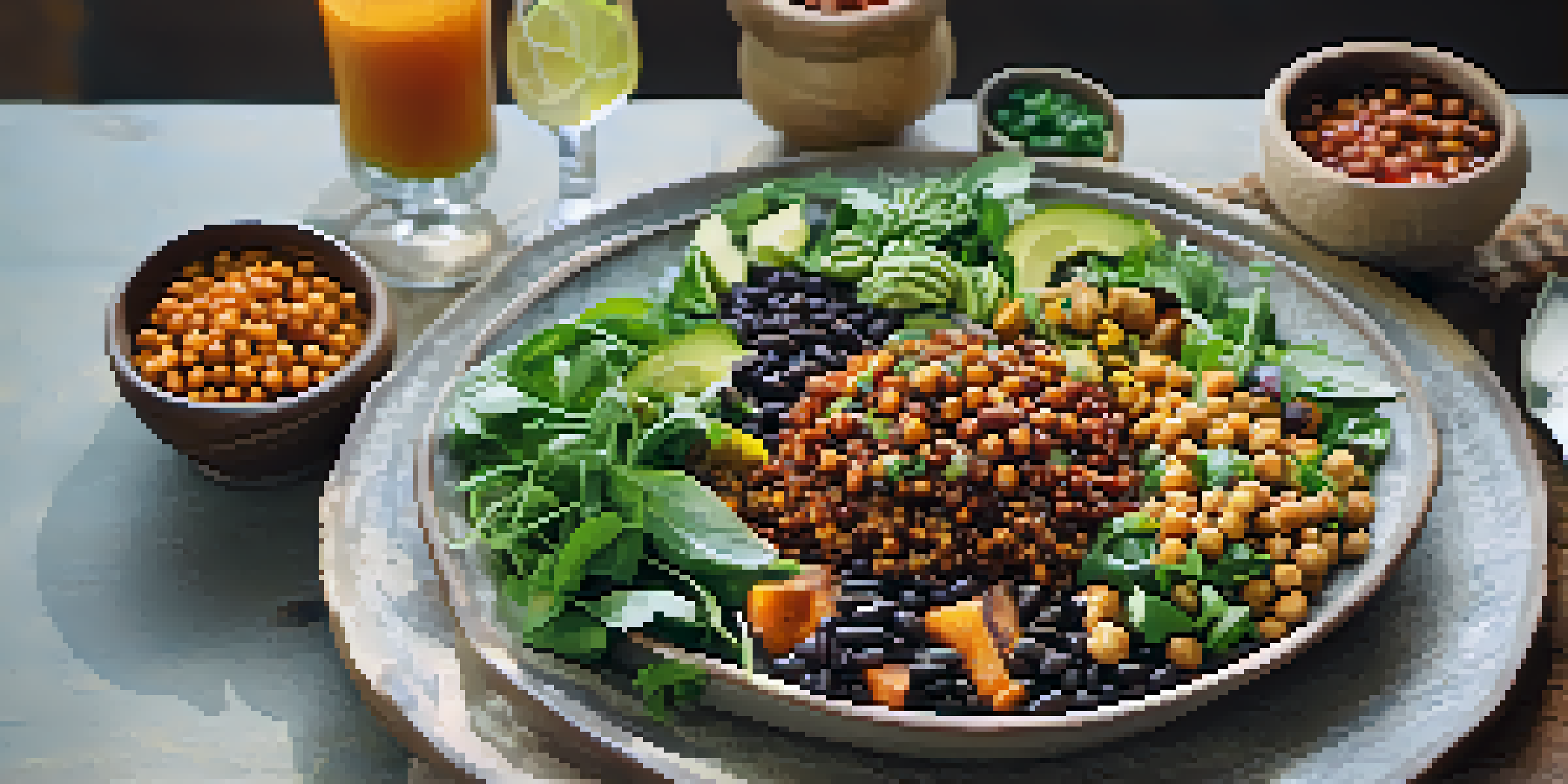Discovering the Benefits of a Flexitarian Diet for Beginners

What is a Flexitarian Diet and Why Choose It?
The flexitarian diet is essentially a flexible approach to eating that emphasizes plant-based foods while allowing for occasional meat consumption. This means you don’t have to give up your favorite burgers or steaks entirely, making it easier for many to adapt. By focusing on vegetables, fruits, legumes, and whole grains, you can enjoy the benefits of a vegetarian diet without the strict rules.
Eating more plants is a great way to improve your health and the health of the planet.
One of the main reasons people choose a flexitarian diet is its balance; it’s not an all-or-nothing approach. This flexibility can lead to lasting lifestyle changes, rather than a short-term diet that feels restrictive. Plus, it encourages mindful eating, prompting you to consider where your food comes from and how it impacts your health.
Moreover, the flexitarian diet is linked to numerous health benefits, including lower risks of heart disease and better weight management. By reducing meat intake and increasing plant-based foods, you can enhance your overall nutrition while still enjoying a varied diet.
Health Benefits of Embracing a Flexitarian Lifestyle
One of the standout benefits of a flexitarian diet is its positive impact on heart health. Studies have shown that diets rich in fruits, vegetables, and whole grains can help lower cholesterol levels and blood pressure. By prioritizing plant-based foods, you're not just filling your plate with nutrients; you're actively supporting your cardiovascular system.

Additionally, a flexitarian diet can be a powerful ally in weight management. With more focus on low-calorie, nutrient-dense foods such as vegetables and legumes, you’re less likely to consume excess calories. This can lead to healthier weight loss or maintenance without the struggle of strict portion control.
Flexibility for Better Eating Choices
The flexitarian diet promotes a balanced approach to eating, allowing for occasional meat while emphasizing plant-based foods.
Don’t forget about the potential environmental benefits, too! By reducing meat consumption, even just a little, you can help lower your carbon footprint. Adopting a flexitarian diet means you’re taking a step towards sustainable eating, which is increasingly important in today’s world.
Getting Started with a Flexitarian Diet
Starting a flexitarian diet doesn’t have to be overwhelming. A great first step is to gradually incorporate more plant-based meals into your week. For example, try 'Meatless Mondays' or experiment with a few vegetarian recipes throughout the week. This way, you can ease into the new lifestyle without feeling pressured to make drastic changes all at once.
Let food be thy medicine and medicine be thy food.
Another helpful tip is to explore local markets or grocery stores for seasonal produce. Fresh, in-season fruits and vegetables not only taste better but also offer the highest nutritional value. Get creative in the kitchen by trying new ingredients or cooking methods to keep your meals exciting and diverse.
Lastly, don’t forget to listen to your body. Everyone’s dietary needs are different, so pay attention to how you feel as you incorporate more plant-based options. Whether it's more energy, better digestion, or simply enjoying your meals more, the flexitarian diet can adapt to what works best for you.
Common Misconceptions About Flexitarian Eating
One common misconception about the flexitarian diet is that it’s just a fancy term for vegetarianism. While it does encourage a plant-based focus, it doesn’t require complete abstinence from meat. This flexibility can make it more appealing, especially for those who enjoy meat but want to eat healthier.
Another myth is that you need to plan every meal meticulously. In reality, a flexitarian diet allows for spontaneity and creativity in your cooking. You can enjoy a delicious steak on the weekend while also embracing a hearty lentil soup on a weekday—there’s no strict regimen to follow.
Health and Environmental Benefits
Adopting a flexitarian lifestyle can lead to improved heart health, better weight management, and a reduced carbon footprint.
Lastly, some may think that a flexitarian diet lacks protein. However, there are plenty of plant-based protein sources available, such as beans, chickpeas, quinoa, and nuts. By diversifying your food choices, you can easily meet your protein needs without relying solely on meat.
Delicious Flexitarian Recipe Ideas to Try
When it comes to flexitarian recipes, the options are virtually endless! Start your week with a mouthwatering black bean and sweet potato chili, packed with fiber and flavor. This hearty dish is a great way to warm up on a chilly evening while keeping meat to a minimum.
For lunch, consider whipping up a colorful quinoa salad loaded with fresh vegetables, chickpeas, and a zesty lemon dressing. This dish is not only nutritious but also super filling, making it a perfect choice for a midday meal. You can even prepare it in advance for a quick grab-and-go option.
Lastly, don’t forget about snacks! Roasted chickpeas or homemade vegetable chips can satisfy those crunchy cravings without veering off your flexitarian path. These healthy alternatives are easy to make and can be customized with your favorite spices.
Navigating Social Situations on a Flexitarian Diet
Social gatherings can sometimes feel challenging when you're trying to stick to a flexitarian diet. However, it’s all about perspective and preparation. When invited to a party, consider suggesting a potluck where everyone can bring a plant-based dish. This way, you ensure there are options that fit your dietary preferences.
If you're dining out, don't hesitate to ask the restaurant staff about vegetarian options or modifications to existing dishes. Many restaurants are becoming more accommodating, and you might be surprised at how flexible they can be. This is an opportunity to explore new flavors while still enjoying the company of friends.
Easy Steps to Start Flexitarian Eating
Begin your flexitarian journey by gradually introducing more plant-based meals and experimenting with seasonal produce.
Lastly, remember that being flexitarian doesn’t mean you have to explain your choices to everyone. Simply enjoy your meal and focus on the company around you. The goal is to cultivate a healthy relationship with food without the pressure of fitting into a specific dietary label.
Tips for Sustaining a Flexitarian Diet Long-Term
To sustain a flexitarian diet in the long run, it’s essential to keep your meals interesting and varied. Experiment with different cuisines, cooking techniques, and seasonal ingredients to prevent monotony. Think of it as a culinary adventure where you’re constantly discovering new flavors and textures.
It can also be helpful to set realistic goals for yourself. Instead of aiming for perfection, aim for balance. Allow yourself to enjoy meat occasionally while focusing on incorporating more plant-based meals into your routine. This mindset can make the transition smoother and more enjoyable.

Finally, don’t forget to track your progress and celebrate your achievements, no matter how small. Whether it’s trying a new recipe or successfully completing a meat-free week, acknowledging your efforts can boost your motivation to stick with the flexitarian lifestyle.